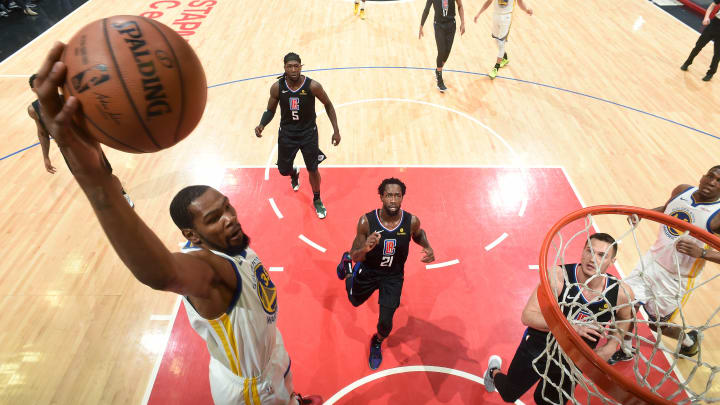The Ultimate Weapon: Kevin Durant's Supernova Turn Closes Out Clippers

When Clippers coach Doc Rivers surveyed his team’s matchup against the Warriors at the start of their first-round series, he chose to pit the 6'1" Patrick Beverley against the seven-foot Kevin Durant for the explicit purpose of denying Durant the freedom to work off the dribble. “You know,” Rivers said after Game 1, “because with Durants, the LeBrons of the world, when you put their same size guy on him, now they have every advantage.” Durant hit enough shots over the top of Beverley, effectively uncontested due to their height difference, as to make the Clippers revisit their matchups mid-series.
Big man JaMychal Green became Durant’s primary defender and Danilo Gallinari his second, while Beverley loomed in help. In the end, it was just as Rivers had feared. After scoring 38 points, 33 points and 45 points in Games 3, 4, and 5, respectfully, Durant ended the series—and the Clippers’ season—with a 50-point salvo fueled by every possible advantage. His performanced landed Golden State a 129-110 closeout win.
“We tried everything,” Lou Williams conceded. “We had several different coverages for KD. And...”
“It didn’t work,” Beverley interjected.
Williams, chuckling, continued. “Sometimes you come across special people and it doesn't matter what you send to them. There's no scheme. There's no defense, no nothing that you can do with special people. He's one of them, and he showed it tonight.”
What Durant showed was that he could fire off 30 points in a 17-minute stretch while only missing three total shots. It was that run, bridging the first and second quarter, that blew open Game 6. The Clippers were powerless to stop him. It was all they could do to compete—challenging Durant however they could, even though most of the damage had already been done. Beverley even got another crack at the assignment before it was all over, though by that point there was little that could be done to stem the tide. “We didn’t roll over,” Beverley said. They didn’t have to. When Durant settles in, he can render a defense irrelevant. A contest from Beverley might not even cross his line of sight. A hard drive turns Green, a fairly mobile big under most circumstances, into a traffic cone.
There is something so free about the way Durant operates in this particular zone. If it seems as though a disproportionate cut of his scoring comes from easy offense, that’s because it does. Durant may be the most accessible transition player in the league, given the way he runs the floor, the skill that allows him to go anywhere on the floor, and the sheer difficulty of altering his shot. On this possession, Durant technically catches the ball at a position of disadvantage: one-on-three with Gallinari in front of him, flanked by Beverley and Green. He winds up taking an eight-foot jumper without so much as a hand in his face:
There are only so many ways for a defense to reconcile the threats that Durant presents in any sort of open floor. With any kind of momentum, Durant can waltz into a pull-up three—a shot that has effectively become his signature.
Honor that possibility, however, and Durant can break the delicate balance of a transition defense. Anything short of a hard contest won’t much influence Durant’s release, and yet even a tilt in his direction leaves a defender vulnerable to his sudden, violent drives.
Amid all of this, opponents must somehow account for not just Durant, but every other Warrior streaking down the floor. Of all the tensions that come in guarding Durant and Stephen Curry at once, none are more paralyzing than the work of juggling both in transition. There are few ways to effectively guard Curry that don’t involve multiple defenders—a fact demonstrated to ridiculous effect by the Clippers effectively doubling Curry off ball screens at halfcourt. A defense on the run tends to process the action through impulse. If Curry readies his feet for a shot from 35 feet out, multiple defenders might lunge toward him and away from Durant, one of the most unstoppable scorers in the league. The break itself is so persuasive that even a game of hot potato between Andre Iguodala and Shaun Livingston can get Durant an open corner three.
Involve Curry or Klay Thompson and defenses will sometimes bend over backwards to betray their best interests. It’s in those cases that Durant becomes the ultimate hammer: a feared shooter who can’t just be chased off the line, and a full-speed terror who can’t just be chased down. Even a perfectly calibrated defense will have a hard time slowing Durant down.
“He's the ultimate weapon because there's no defense for Kevin,” Warriors coach Steve Kerr said. “No matter what anybody does, he can get a good shot.” With a little pace, Durant can so easily get a great one. It’s in the open court that matchups become fluid, and defensive schemes a matter of improvisation. There’s no time to scramble the one similarly sized player on the floor into Durant’s path. Sometimes it’s a matter of a player like Beverley stepping up because no one else can, and watching as Durant hoists up a shot literal feet above his head.
What makes Durant such an impossible cover isn’t his unblockable fadeaway. It’s how easily his game lends itself to the best kinds of shots, and what little a defense can do to actually stop them.

Rob Mahoney is an NBA writer dedicated to the minutiae of the game of basketball, its overarching themes and everything in between. He joined the Sports Illustrated staff in 2012.